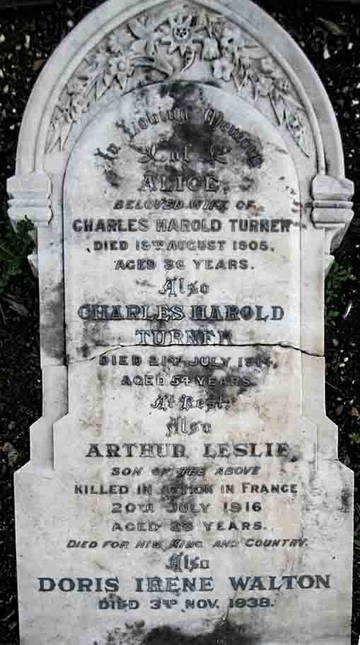
‘Died for His King and Country
Arthur Leslie TURNER
Eyes brown, Hair black, Complexion dark
Arthur Turner - “Spent the Night in the German Front Line”
Can you help us identify Gunner Arthur Turner?
From his later memorials, he was known to the family as Les.
Les was Killed in Action at Fromelles. As part of the 8th Machine Gun Company, he was positioned near where the Germans collected soldiers who were later buried at Pheasant Wood. The Germans returned his Identity Disc.
There is a chance he might be identified, but we need help. We are still searching for suitable family DNA donors. As of 2024, 180 of the 250 soldiers in the mass grave have been able to be identified by DNA matching from family members. 113 of the 372 unidentified soldiers from the 8th Brigade have been found to be in the grave and Les’s ID tags had been recovered by the Germans, so he well could be one of the remaining unidentified soldiers.
If you know anything of contacts here in Australia or his relatives from Yorkshire, please contact the Fromelles Association. A Turner male relative in the UK was pleased to donate DNA. A second male TURNER would also assist, Mexborough and Sheffield areas.
DNA - It is the female line now needed, two from the Ogden and Sugden lines of Bingley Yorkshire, Binns and Clough line of Keighley, Yorkshire.
See the DNA box at the end of the story for what we do know about his family.
With thanks to relatives Alan Waddington and Martyn Turner who contributed to the family story.
Early Life
Arthur Leslie Turner was born in August 1893 to Harold (Charles Harold) and Alice (nee Waddington) Turner. Harold Turner and his siblings, Albert and Thirza, had migrated from Mexborough, Yorkshire. Alice had come to Australia in 1883 from Keighley in Yorkshire with her father Mitchell Waddington, stepmother Matilda (nee Leach) and four half siblings.
The family was well engaged in the community. In his obituary, her father was noted as “an old identity of the district”, from being one of the founders of the Balmain Co-operative Society, a supporter of the local Mechanics' Institute and for 40 years he was an active member of the Protestant Alliance Friendly Society.
Source: Death of Mr. M. Waddington (1927, July 9). The Daily Telegraph (Sydney, NSW 1883 - 1930), p. 11, http://nla.gov.au/nla.news-article246985811
Alice and Harold met and married in Balmain, Sydney in 1891. The Aussie Turner children were:
- Annie Elizabeth 1891-1975, married Arthur Walton in 1912.
- Arthur Leslie (Les) 1893-1916, KIA Fromelles
- John (Jack) Mitchell 1901-1943, married Mabel Guthrie, four children.
Unfortunately, Alice died in 1905 when Les was only eight and Jack four. At that stage Annie was 14 and would have helped to look after her younger brothers over the next few years. Then their father Harold died exactly two years earlier than Les on the 20th July 1914. Les may have lost both his parents by the time he went to War, but he still had maternal grandparents. After his schooling, he did apprenticeships in shipping at Mort’s Dock and at J.T. Jay’s and then had become a patternmaker.
Off to War
Les enlisted in July 1915, a month shy of his 22nd birthday. His enlistment papers note his complexion as ‘dark’ and he did become known as ‘Darkie’ by his fellow soldiers. He was assigned to the newly formed 30th Battalion in the Machine Gun Company. Training commenced in the Liverpool camp, but in September they moved to the Royal Agricultural Show Grounds in Moore Park, Sydney. There were numerous reports of their activities in the papers.
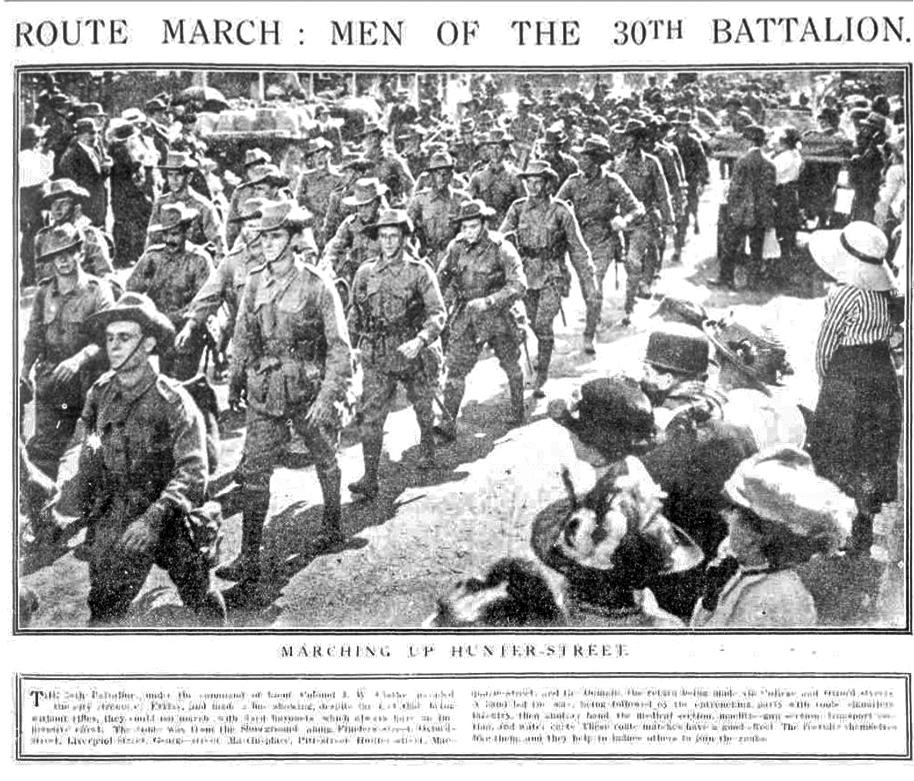
The Battalion left Sydney for Egypt aboard HMAT A72 Beltana at 3.30 PM on 9 November 1915. Their one month trip was uneventful, and they disembarked in Egypt on 11 December.
Egypt and on to the Western Front
Their first seven weeks were spent at Ferry Post guarding the Suez Canal and continuing their training. In February they moved to the camp at Tel el Kebir. With all the influx of recruits from Australia, reorganisations were underway in in early March and Les was reassigned to the 8th Brigade Machine Gun Company, who would be supporting the Brigade’s four Battalions. For much of April and May Les was back in Ferry Post, including some time in the front-line trenches there.
There were the usual complaints of the heat, water supplies and flies. Les left Egypt for the Western Front on 16 June 1916 aboard the Tunisian and arrived in Marseilles on 23 June. After landing, there was a 60+ hour train ride to Hazebrouck, 30 km from Fleurbaix. They arrived on 29 June and then encamped in Morbecque. The 30th Battalion’s Private F.R. Sharp (2134) wrote home about the trip:
“From the time we left Marseilles until we reached our destination was nothing but one long stretch of farms and the scenery was magnificent.” “France is a country worth fighting for.”
Training now included the use of gas masks, and they also would have heard the heavy artillery from the front lines.
The Battle of Fromelles
Machine Gunners were an essential part of an attack, but in the circumstances at Fromelles they were challenged by the requirements of the legendary Vickers Medium Machine Guns.
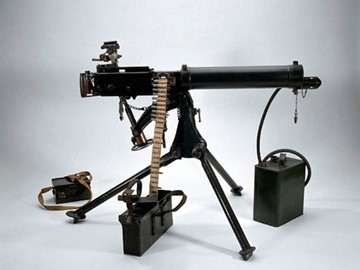
The gun has a crew of three. It was not easily portable and was preferably sited in a prepared fixed position. In an attack the gun would be sited to provide indirect 'plunging fire' into enemy positions to prevent enemy reinforcements reaching the objective of the attack, similar to artillery, or to provide defensive fire across the front of the "limit of exploitation" of the attack as protection against counterattack by the enemy. However, it was a target for the enemy, it was heavy and it had to be moved forward as needed while under fire, exposing the machine gun crews.
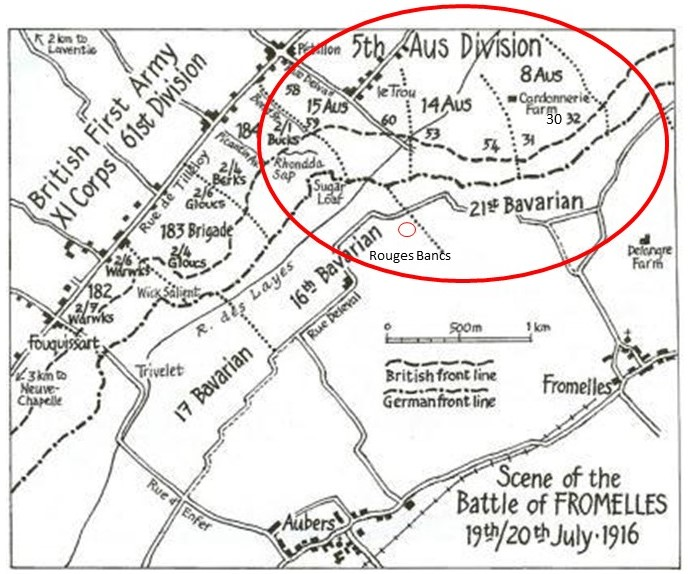
The 8th Brigade’s position was on the left flank of the Australian attack, with only 100 metres of No Man’s Land to get the German trenches. As they advanced they were to link up with the 14th Brigade on their right. However, their position on the extreme left flank made their job more difficult, as not only did they have to protect themselves while advancing, but they also had to block off the Germans on their left, to stop them from coming around behind them.
The attacking 31st and 32nd Battalions were in position by 5.45 PM and the charge over the parapet began at just before 6.00 PM. They were successful in the initial assaults and by 6.30 PM were in control of the German’s 1st line system (map Trench B), which was described as “practically a ditch with from 1 to 2 feet of mud and slush at the bottom”.
Source: AWM4 23/49/12, 32nd Battalion War Diaries, July 1916, page 11

Unfortunately, with the success of their attack, ‘friendly’ artillery fire caused a large number of casualties. They were able to take out a German machine gun in their early advances, but were being “seriously enfiladed” from their left flank. By 8.30 PM the Australians’ left flank had come under heavy bombardment with high explosives and shrapnel. Return bombardment support was provided and they were told that “the trenches were to be held at all costs”.
Source: AWM4 23/49/12, 32nd Battalion War Diaries, July 1916, page 12
Fighting continued through the night. The Australians made a further charge at the main German line beyond Trench B, but they were low on grenades, there was machine gun fire from behind from the emplacement at Delangre Farm and they were so far advanced that they were getting shelled by both sides. At 4.00 AM the Germans began an attack from the Australian’s left flank, bombing and advancing into Trench A (map). Given the Australian advances that had been made earlier, portions of the rear Trench E had been left almost empty, which then enabled the Germans to be in a position to surround the soldiers. At 5.30 AM the Germans attacked from both flanks in force and with bombing parties”
` “The enemy swarmed in and the retirement across No Man’s Land resembled shambles, the enemy artillery and machine guns doing deadly damage.” `
[[Source: AWM4 23/48/12, 31st Battalion War Diaries, July 1916, pages 29]]
By 10.00 AM on the 20th, the Germans had repelled the Australian attack and the 30th Battalion were pulled out of the trenches. The efforts of the Machine Gun Company were well recognised by the Commanders – “a tower of strength and all ranks did everything that was possible for men to do.”

However, the nature of this battle was summed up by Private Jim Cleworth (784) from the 29th:
The novelty of being a soldier wore off in about five seconds, it was like a bloody butcher's shop
The ultimate impact for the 8th Brigade was that 607 were killed or died of wounds and of this, 372 were not able to be identified.
Les’s Fate
Based on a fellow soldier’s witness statements to the Red Cross, Les was well into the German lines late in the night, fighting bravely to hold back the Germans until the orders to retreat came. Remaining to the end to cover the retreat of his comrades, Les was preparing to withdraw himself, packing up his machine gun and beginning the trip back across No Man's Land, carrying the gun's tripod, when he was killed.
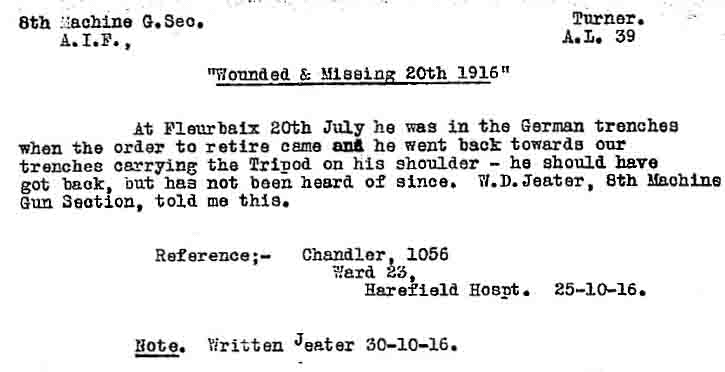
Corporal William Jeater went on to say:
“Pte Turner and myself left our lines together, and finally spent the night in the German front line, which place was where I last saw him, alive and well. As the enemy was shelling and bombing heavily at the time, I am afraid he was either killed or seriously wounded in that trench, as I left after him and saw no sign of him on the way back. It was light at the time and he only left me a few minutes prior to our retirement ... I was the last to leave and left a lookout for any of our section that may have been less fortunate. I saw no sign of him either in the German trench or in No Man's Land that instead or (sic) going to the right he went to the left, and so met disaster.”
In October, the Army received notification that Les was found by the Germans after the battle and his identity disc was returned to the Australians.

The Family Waits
With the huge impact of the battle, the Army had a significant challenge to get reliable information back to the families. The family were advised that he was missing, but there was little else they could offer at the time. In early October, the Army received notification that Les had been found by the Germans after the battle and his identity disc was returned to the Australians.
This information did not make it back to the family quickly, however, and in November his grandparents wrote to their MP, W.G. Mahony.
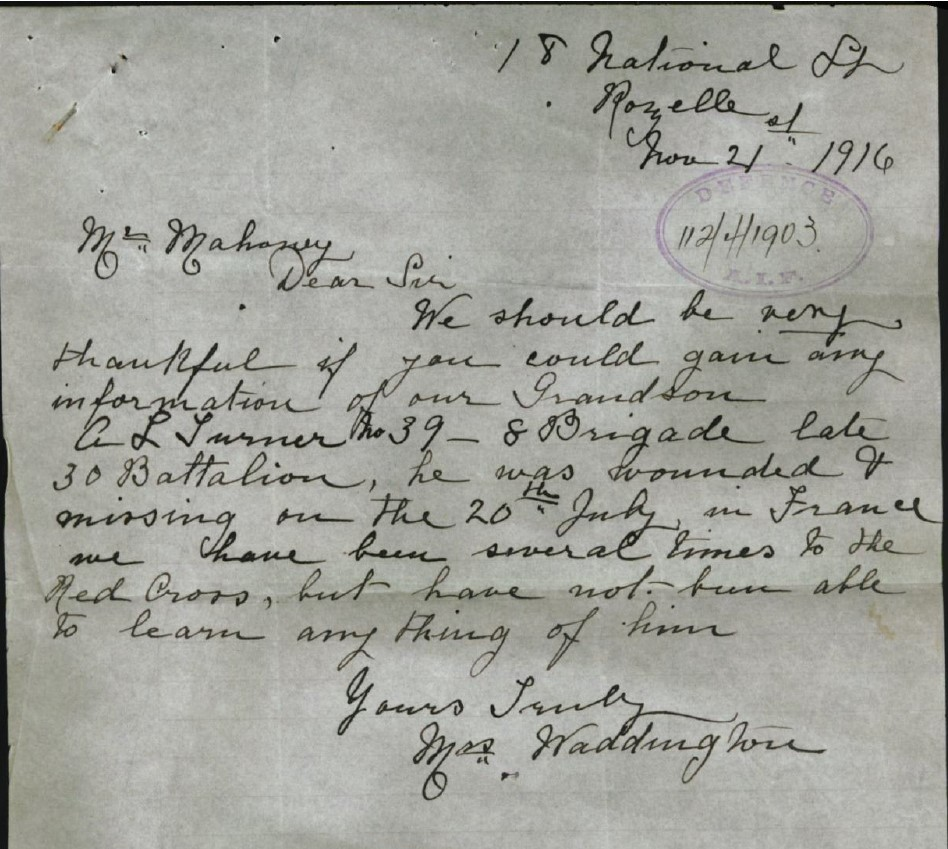
Mr. Mahony passed the letter on to the Acting Secretary of Defence T. Trumble, who then asked Base Records for “early attention”. A reply was made, which was blunt, but honest (emphasis added):
“I regret, without the production of some definite authentic evidence, at variance with the official report, my instructions preclude any investigations being made from this end at present, particularly when it is remembered that the whole of the machinery of the British Army is available, and is being utilized, with a view of cleaning up these unsatisfactory cases. Needless to say, anything further coming to had will be promptly transmitted to the registered next of kin, who is shown as his sister.”
With the Red Cross statements and German reports in hand, on 7 January 1917 Arthur was formally declared as having been killed in action on 20 July 1916.
Memorials
Newspaper memorials from the time outline the sorrow of his family:
TURNER . - Killed In action in France, July 2Oth.
Gunner Arthur Leslie Turner, aged 23 years,
Inserted by his loving grandparents, Mr and Mrs M Waddington and family.
Another reads:
TURNER. - Killed in action in France, July 20, 1916,
Gunner Arthur Leslie Turner, aged 23 years.
Sweet is the memory that never will fade.
Dear is the country where our dear Les is laid.
Inserted by his Sorrowing brother, Jack, sister and brother-in-law, Mr. and Mrs. A. A Vallon.
Les was issued the 1914-15 Star Medal, British War Medal, Victory Medal and a Memorial Plaque and a Memorial Scroll. While his sister was next of kin, these were ultimately issued to his brother, per Army protocols at the time.
Les is commemorated at:
- V.C. Corner (Panel No 23), Australian Cemetery Memorial, Fromelles
- The grave of his mother and father in Gladesville, Sydney.
- Field of Mars Cemetery, Ryde, New South Wales on family gravestone.
- Australian War Memorial, Panel 179

Still Searching After the War, and Could Les Still Be Found?
With the rather black and white ‘Army’ responses to the losses of loved ones, a number of people looked for support and comfort from Church and other sources, spiritualism being one of them. In 1922, his aunt Mrs I. Whittington (who lived in Queensland) wrote to the Army that Les’s sister had been to a spiritual meeting and she was now under the impression that Les was not dead and was instead in a hospital in Flanders without any memory.

The Army replied that they had no reasons to question the authenticity of Les’s death. However, after the battle, German soldiers removed 250 Australian casualties from battlefield, burying them in large pits near Pheasant Wood. This mass grave was not discovered until 2008. As of 2024, 180 of the 250 soldiers in the grave have been able to be identified by DNA matching from family members.
113 of the 371 unidentified soldiers from the 8th Brigade have been found to be in the grave and Les’s ID tags had been recovered by the Germans, so he well could be one of the remaining unidentified soldiers. A male family donor has been found, but we need to find a female family member to contribute DNA samples to be able to confirm Les’s identity.
If you know anything of contacts here in Australia or his relatives in England, please contact the Fromelles Association.
DNA samples are being sought for family connections to ARTHUR, (Mt on his mother’s side)
| Soldier Arthur Leslie Turner (1893-1916) missing Battle of Fromelles | known as Les by family |
| Parents | Charles Harold Turner (1862-1914) Mexborough, Yorkshire and Alice Waddington (1879-1905) Keighley Yorkshire. Met and married in Australia |
| Siblings | Annie Elizabeth Turner (1892-1975) Married Arthur Edward Walton | ||
| John Mitchell Turner (1901-1943) Married Mabel Guthrie, son John Mitchell Turner, daughters Belle, Ruth and Heather. |
| Grandparents | |||
| Paternal | John Turner (1830-1877) Mexborough, Yorkshire and Grandmother Sarah Anne Reynolds (1833-1883) Sheffield, Yorkshire | ||
| Maternal | Mitchell Waddington (1852-1927) Keighly, Yorkshire and Susannah Ogden (1843-1871) Bingley, Yorkshire |
For DNA, we need Alice’s maternal line of OGDEN and SUGDEN from Bingley and BINNS and CLOUGH of Keighley in Yorkshire.
Note. Alice Waddington was an only child and had only three children herself.
Seeking DNA Donors

Contacts
(Contact: carla@fromelles.info or geoffrey@fromelles.info).
(Contact: army.uwc@defence.gov.au or phone 1800 019 090).
Donations
If you are able, please contribute to the upkeep of this resource.
(Contact: bill@fromelles.info ).